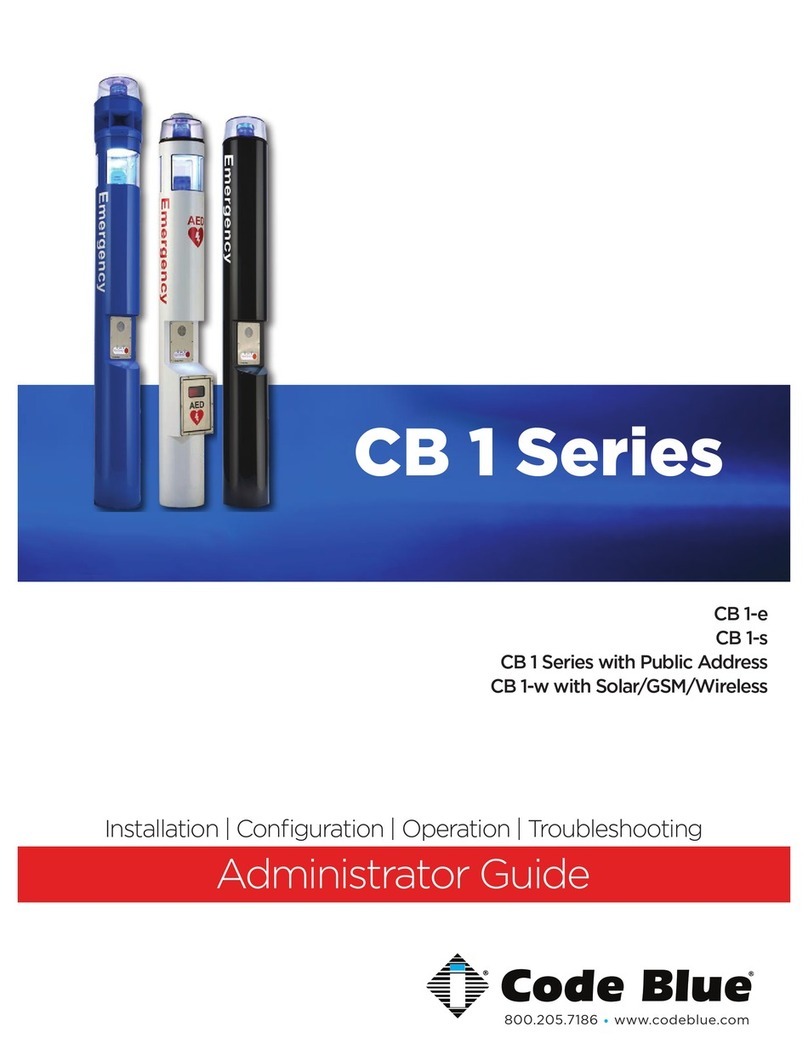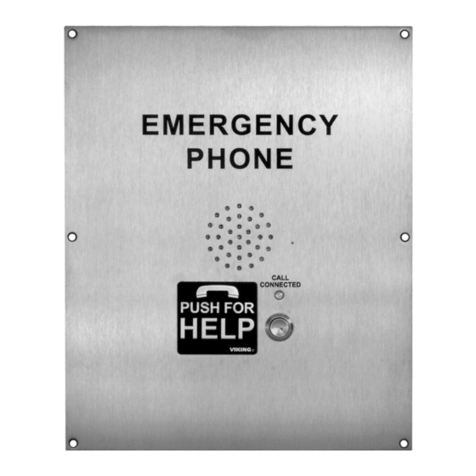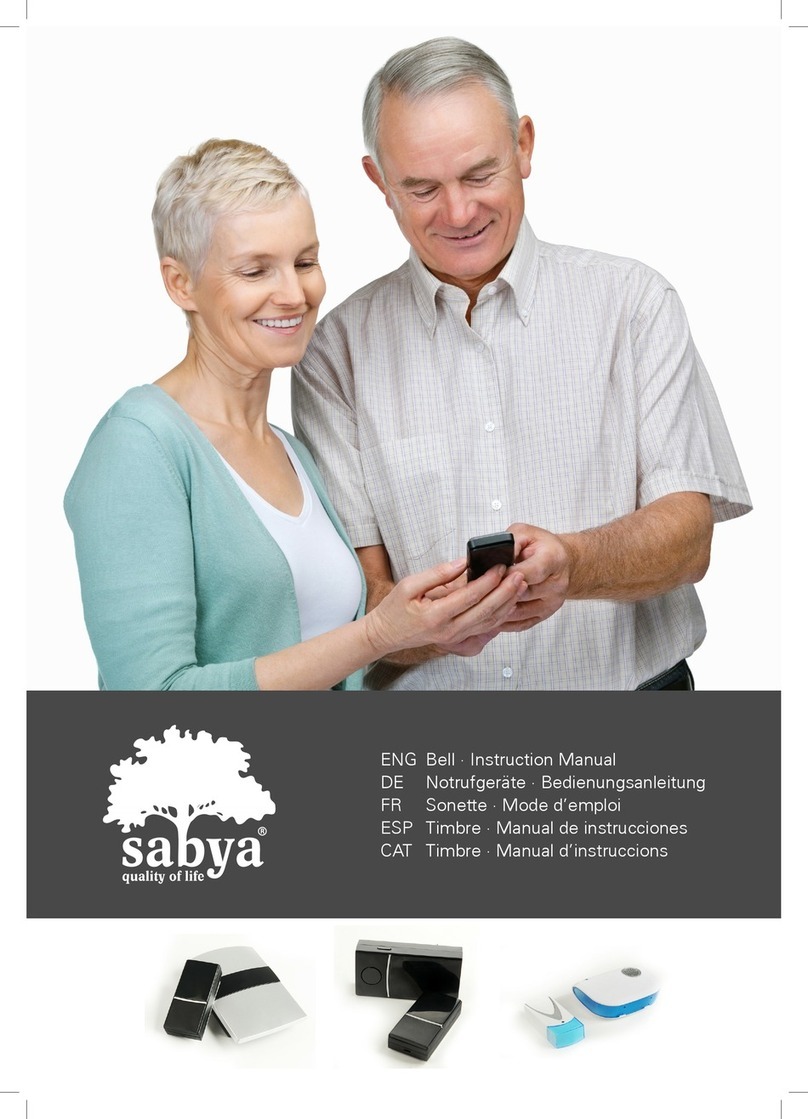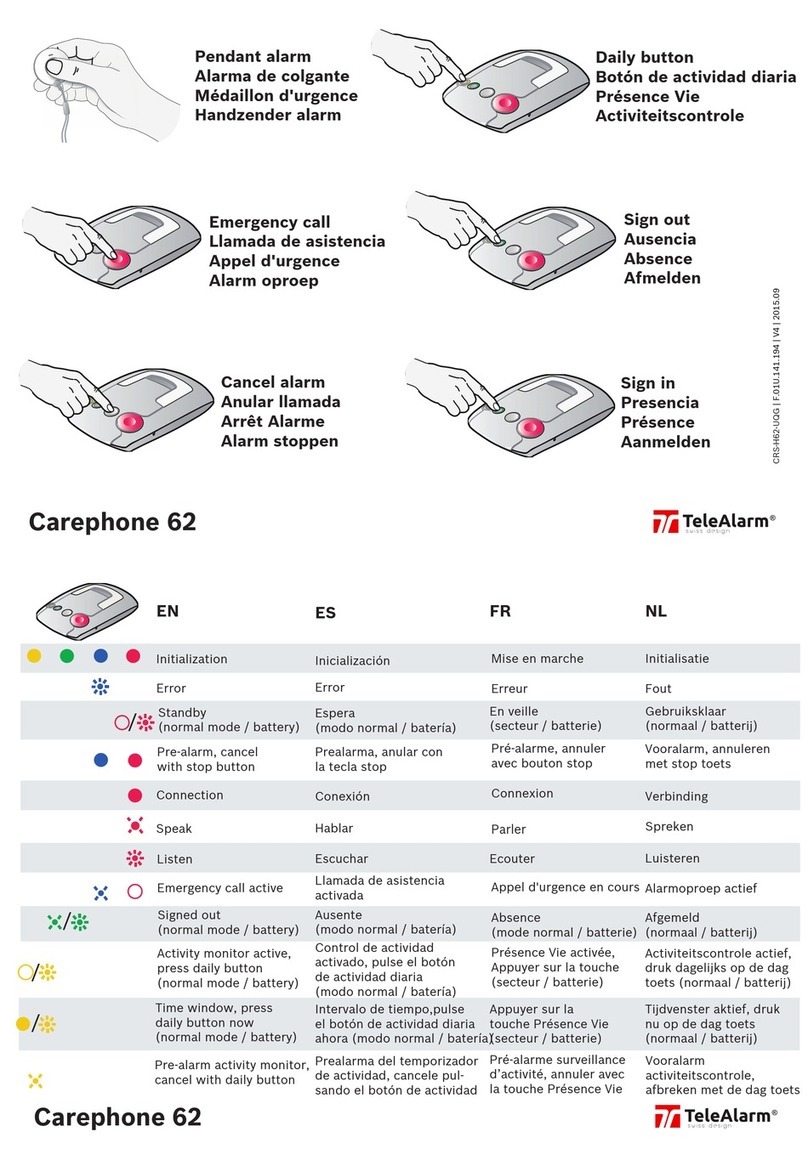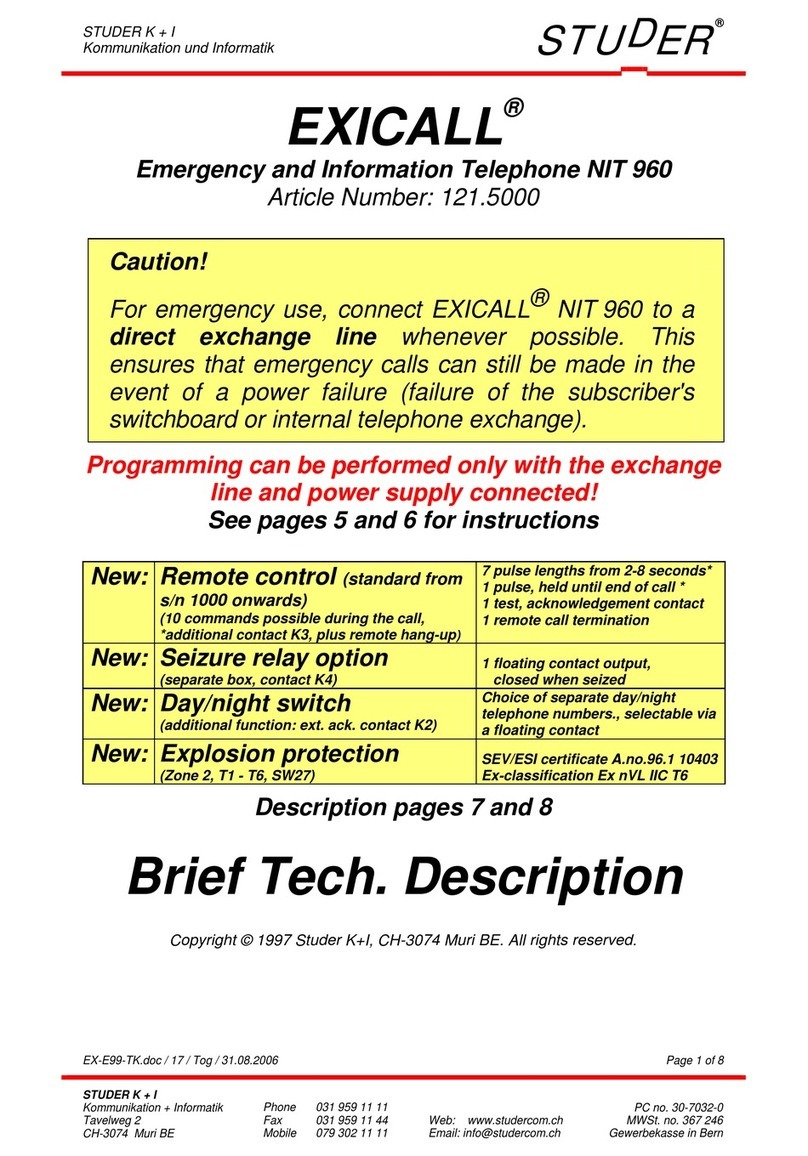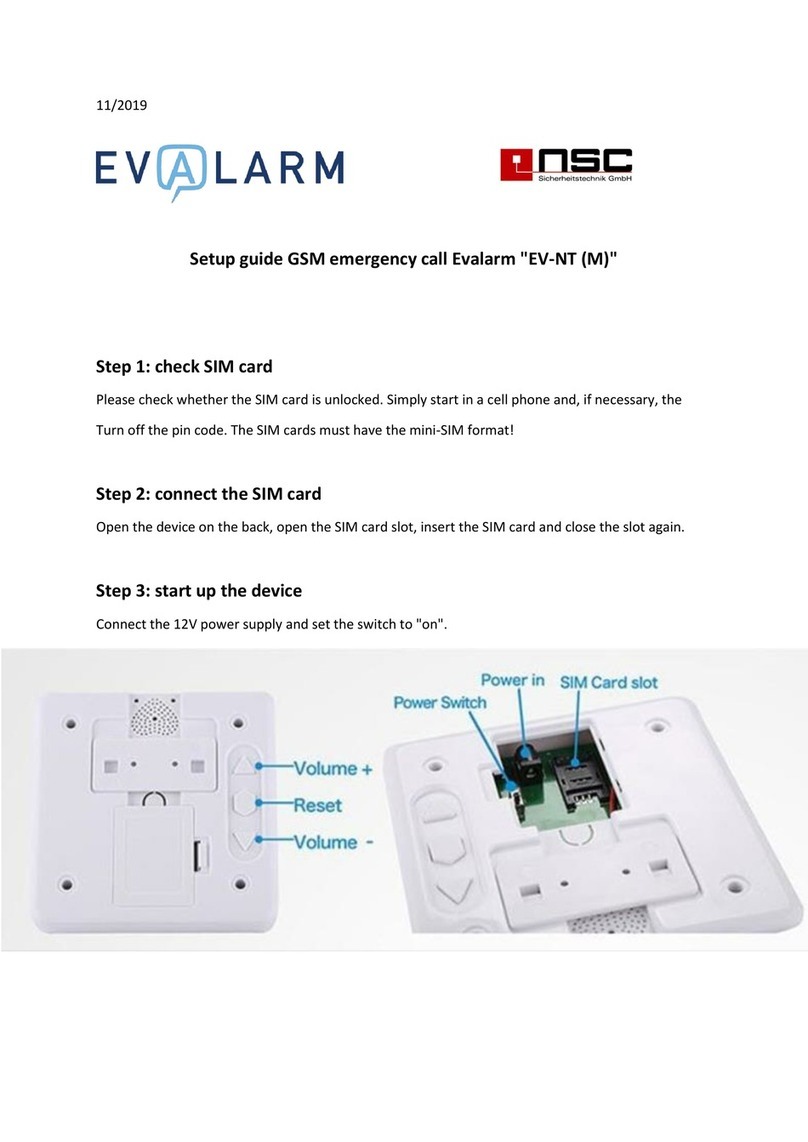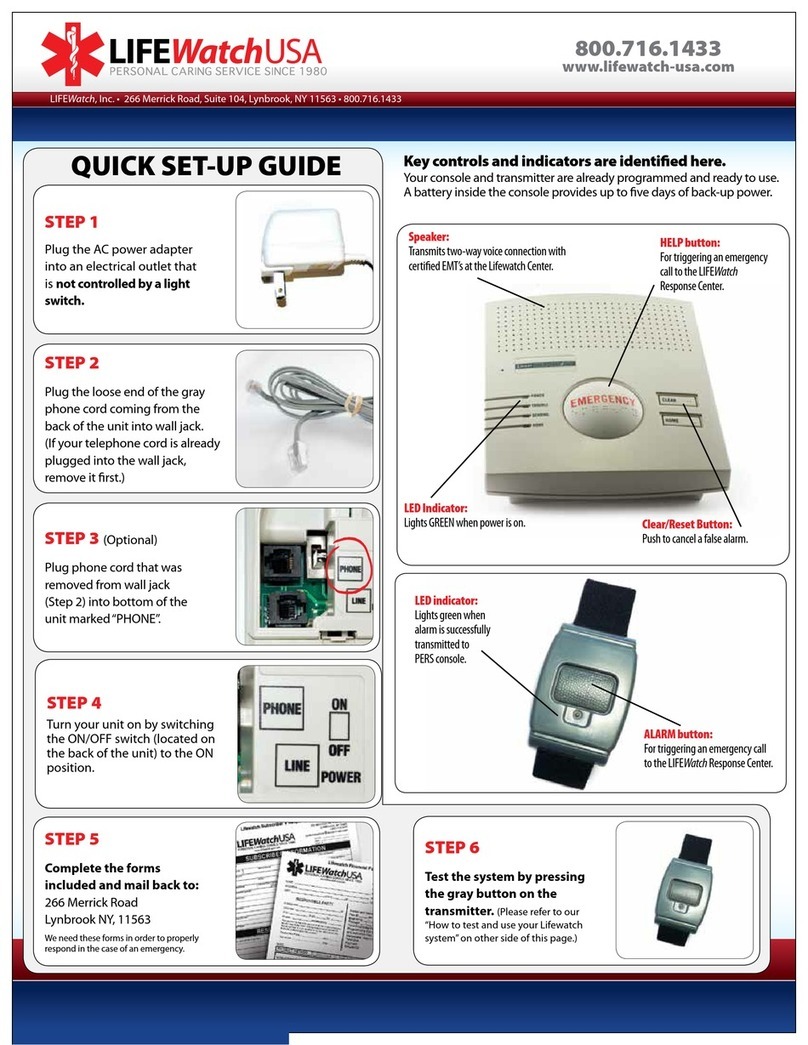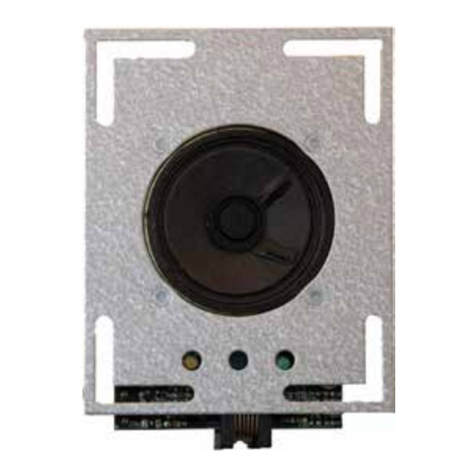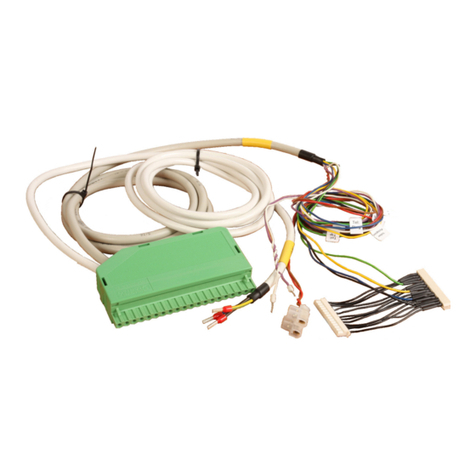HD ADA 100 User manual

OPERATIONS
&
INSTALLATION
GUIDE
ADA 100®
EMERGENCY CALL SYSTEM
VERSION 5.1a
JUNE 1998
HOUSING DEVICES, INC
407 R. MYSTIC AVE.
MEDFORD, MA 02155
800-392-5200

ADA 100® Emergency Call System
Housing Devices, Inc. Page 2
Medford, MA 02155 Copyright © 1998 800-392-5200
TABLE OF CONTENTS
INTRODUCTION Page 3
SYSTEM DESCRIPTION Page 4
SYSTEM OPERATION Page 4
MASTER STATION OPERATION Page 4
AREA STATION OPERATION Page 5
SYSTEM CONSTRUCTION Page 5
MASTER STATION INDICATORS & CONTROLS Page 5
Visual Indicators Page 5
Audio Indicators Page 5
System Power Indicator Page 6
Communication ControlsPage 6
System Reset Control Page 6
AREA STATION INDICATORS& CONTROLS Page 6
Visual Indicators Page 6
Audio Indicators Page 6
Communication Controls Page 6
POWER REQUIREMENTS Page 7
SYSTEM COMPONENTS Page 7
MASTER STATION Page 7
AREA STATION Page 7
RELAY CARD CABINET Page 7
RELAY CARD Page 7
CONTROL BOARD Page 8
BATTERY BACKUP SYSTEM CABINET Page 8
AMPLIFIER Page 8
BRAILLE INSTRUCTIONAL SIGN Page 8
ILLUMINATED AREA STATION SIGN Page 8
INSTALLATION Page 9
UNPACKING Page 9
BACK BOX Page 9
SURFACE MOUNTING COLLAR Page 10
MASTER STATION Page 10
AREA STATION Page 10
RELAY CARD CABINET Page 10
BATTERY BACKUP SYSTEM CABINET Page 10
INSTRUCTIONAL SIGNS Page 10
SYSTEM WIRING AND CONNECTIONS Page 11
GENERAL Page 11
MASTER STATION WIRING Page 11
AREA STATION WIRING Page 11
RELAY CARD CABINET WIRING Page 11
BATTERY BACKUP SYSTEM WIRING Page 11
TROUBLE-SHOOTING Page 12
APPENDIX Page 15
WIRING DIAGRAMS APPENDIX
ADA 100 System Riser Diagram Page 1
Master Station Hook Up Diagram Page 2
Master Station Expansion Hook Up Directions Page 2A
Area Station Hook Up Diagram Page 3
Relay Card Cabinet Hook Up Diagram Page 4
Battery Backup Hook Up Diagram Page 5

ADA 100® Emergency Call System
Housing Devices, Inc. Page 3
Medford, MA 02155 Copyright © 1998 800-392-5200
Introduction
Congratulations on your decision to choose the ADA 100 Emergency Call System from
Housing Devices, Inc. Since the inception of the American with Disabilities Act the ADA
100 has been the superior choice of architects and engineers throughout the U.S.A.
The ADA 100 Emergency Call System incorporates state of the art design developed from
years of actual field experience installing over 1,000 devices at hundreds of sites. The
ADA 100 is a hard wired system that can be operated independently of any other building
systems or interfaced with your existing annunciator or fire alarm system. It is easy to
install and designed to provide you with years of trouble free use with virtually no
maintenance needed.
The new ADA 100 delivers unparalleled performance with the same superior quality and
support that companies throughout the country have come to expect from Housing
Devices.

ADA 100® Emergency Call System
Housing Devices, Inc. Page 4
Medford, MA 02155 Copyright © 1998 800-392-5200
System Description
The ADA 100 is a modular, hands-free Emergency Call System with dual audio and visual
alarms and built in supervision capabilities designed to comply with the Americans with
Disabilities Act. The ADA 100 Emergency Call System is a hard wired system needing
only a simple connection to AC power and/or auxiliary DC power to operate. The system
can be operated independently of any other building systems or interfaced with your
existing annunciator or fire alarm system.
Each ADA 100 installation consists of at least one Master Station,one or more Area
Stations, Relay Card Cabinet (with one Control Board and one or more Relay Cards, and
Battery Backup Power Supply System.Each Master Station and each Area Station are
mounted using either a Flush Back Box or Surface Mounting Collar. Tamper Proof
hardware and a Tamper Driver (socket only) are also included with each system. Optional
system components include Braille Instructional Signs in 18 gauge stainless steel frames,
Illuminated “Area of Rescue Assistance” signs with universal mounting hardware and
independent battery backup system (also available without battery backup), telephone
dialers (4 number capacity) and remote Area Station mounted strobe lights.
System Operation
All conversations are controlled at the Master Station using the specific “TALK” and
“LISTEN” metal buttons identified for each Area Station location in the system.
Operation of the system is confirmed at both the Master Station and Area Stations by
means of audio and visual indicators. These indicators verify to the security attendant that
the system is fully operational. They identify locations requesting assistance, alert the
security attendant to respond to the request(s) for help from the Area Station location(s),
and establish two-way communications. All conversations at the Area Station are “hands-
free” after the initial system request.
Master Station Operation
When the system is activated by a request for help from an Area Station, a 90 dbA sound
will occur through the Master Station and a steady red LED identified with a specific Area
Station location (engraved label) will illuminate. The security attendant operates the
system by depressing the metal “TALK” button on the Master Station for each specific
Area Station location to establish a dialog with the person in need of help. This will:
•Silence the piezoelectric alarms at both the Master Station and the Area Station
•Illuminate the red LED labeled “HELP COMING” at the Area Station
•Open up a two-way communication channel with the Area Station so that the
security attendant can converse with the person requesting help
•Depressing the metal “LISTEN” button at the Master Station enables the security
attendant to hear the person’s response
Resetting the system is accomplished by turning the reset key at the Master Station. This
will extinguish the “HELP COMING” light(s) at all Area Station(s) and the Master
Station.

ADA 100® Emergency Call System
Housing Devices, Inc. Page 5
Medford, MA 02155 Copyright © 1998 800-392-5200
Area Station Operation
Depressing the large 3” “PUSH FOR HELP” button on the Area Station activates the
system. This initiates a request to the Master Station and:
•Sounds the piezoelectric alarms at both the Master Station and the Area Station
•Illuminates the red LED labeled “HELP REQUESTED” at the Area Station and the
red LED corresponding to that specific Area Station at the Master Station
•Enables hands-free two-way communication at the Area Station upon
acknowledgement by the security attendant at the Master Station
Resetting the Area Station is accomplished by turning the reset key at the Master Station.
This will extinguish the “HELP COMING” LED at the Area Station(s) and the red LED(s)
at the Master Station, and return them to the standby mode.
System Construction
All external system panels are constructed using 16 gauge (0.062”) stainless steel
providing architecturally pleasing design and years of trouble free performance. ADA 100
Master and Area Stations are designed, manufactured, and tested by Housing Devices to
ensure the highest standards of system integrity and performance.
System interconnections are accomplished using labeled captive screw “plug-in”
connectors to simplify and expedite installation. The system’s independent supervision
helps to promote easy trouble-shooting via rapid problem identification and repair. The
ADA 100 self-identifies system problems using its supervisory circuits to illuminate amber
colored “trouble LEDs” located at the Master Station for each independent Area Station
location that is affected.
If a system wide power fault occurs the ADA 100 continues to operate utilizing the battery
backup system ensuring continued emergency call system viability and availability.
Master Station Indicators and Controls
Visual Indicators
The Master Station utilizes red colored SuperBrite®LEDs (one per each Area Station
location or “area”) to visually indicate a request for assistance has originated from an Area
Station location. The Master Station utilizes amber colored SuperBrite® LEDs (one per
each Area Station location or “area”) to visually indicate that a fault has occurred at a
particular Area Station(s) or in the wiring between the Master Station and Area Station(s),
or if the Master Station has failed.
Audio Indicators
The Master Station utilizes a piezoelectric alarm to generate a 90 dbAsignal through the
Master Station to aurally indicate to the security attendant that a request for help has been
generated. It will remain active until the security attendant at the Master Station initiates a
response by depressing the metal “TALK” button on the Master Station.

ADA 100® Emergency Call System
Housing Devices, Inc. Page 6
Medford, MA 02155 Copyright © 1998 800-392-5200
System Power Indicator
A green colored SuperBrite®LED located directly beneath the system “RESET”.power
key switch indicates system power. When the system is operating normally, the LED will
be illuminated.
Communication Controls
There are two large (7/16”) flat metal buttons under headings labeled “TALK” and
“LISTEN” for each Area Station location in the system. The name of each Area Station
location is permanently engraved on the Master Station next to the specific buttons for that
location. Optional engraved directories identifying each Area Station are also available to
provide for future system growth or changes without having to power down the system, or
to dismantle or exchange the Master Station. These controls are only active when help has
been requested from an Area Station location. Communications from the Master Station
may be made to one or more Area Stations at the same time in order to maximize response
to emergency situations in the event that they are of a more building wide nature.
System Reset Control
A keyed switch with momentary “RESET”position is provided on the Master Station to
reset the entire system following a request(s) for help. The normal position of the key
switch is straight up or ON. The ON position of the key switch is the only position in
which the key may be removed.
If a fault occurs, the system is designed to stay “on line” and continue to provide
emergency call capability from each Area Station without the system needing to be RESET.
Area Station Indicators and Controls
The Area Station communicates directly with the Master Station. Depressing the 3”
“PUSH FOR HELP” button initiates a request for assistance from the Master Station, and
permits hands-free (from the Area Station) two-way communications between the Master
Station and Area Station(s).
Visual Indicators
The Area Station utilizes two red colored SuperBrite® LEDs to visually indicate that a
request for help has been generated from the Area Station location and that the “HELP
REQUESTED” LED is acknowledged from a security attendant at the Master Station.
Permanently engraved and backfill painted acknowledgement labels (“HELP
REQUESTED” and “HELP COMING”) are located next to each LED.
Audio Indicators
The Area Station utilizes a piezoelectric alarm to generate a 90 dbA signal through the
Area Station to aurally indicate to the caller that a request for help has been generated. It
will remain active until the security attendant at the Master Station initiates a response by
depressing the metal “TALK” button on the Master Station.
Communication Controls
A large (3”) domed stainless steel button surface engraved with the words “PUSH FOR
HELP” backfill painted in red is used to initiate a request for help from an Area Station.

ADA 100® Emergency Call System
Housing Devices, Inc. Page 7
Medford, MA 02155 Copyright © 1998 800-392-5200
Power Requirements
The ADA 100 Emergency Call System has an input voltage of 120 VAC, converting to
24VDC @ 1 amp.This connection is made at the systems Relay Card Cabinet which
houses the system’s electronics.
The ADA 100 Emergency Call System also features a 24VDC battery backup system
supplying 1.0 amps for each group of ten (or multiples of 10) Area Stations to ensure
auxiliary power in the event of a power outage. Larger power supplies are included with
larger systems.
System Components
Master Station
The Master Station is a 16 gauge (0.062) 304 brushed stainless steel vandal resistant unit
that is the heart of the system from which all calls are controlled. Each Master Station
contains a 90 dbA piezoelectric audio alarm, red, green and amber colored LEDs as visual
indicators, a system RESET key switch, and engraving identifying each Area Station
location. The size of the standard (1-5 areas) flush mounted Master Station is 11” x 11”.
Master Station size depends on the number of Area Stations in the system. Consult the
manufacturer for larger Master Station dimensions.
A Master Station can accommodate up to 60 Area Stations. The baseline Master Station
accommodates 1-5 Area Stations. The next larger size Master Station accommodates 6-10
Area Stations. The next larger size Master Station accommodates 11-15 Area Stations,
then 16-20 Area Stations and so forth, up to 60 Area Stations. Multiple Master Stations
may be used to accommodate larger systems. Master Stations should be mounted in an
appropriate and secure area (manned location) typically adjacent to other security
equipment.
Area Station
Area Stations are 9” x 9” 16 gauge (0.062) 304 brushed stainless steel vandal resistant
units that are used to communicate directly with the Master Station. Each Area Station
features a 90 dbA piezoelectric audio alarm, red colored LEDs as visual indicators and a
large (3”) domedstainless steel engraved and backfill painted panic button labeled “PUSH
FOR HELP”. Area Stations should be mounted in areas where they are visible and easily
accessible by anyone needing help.
Relay Card Cabinet
The standard size Relay Card Cabinet (12” x 12” x 4”) holds up to 10 Relay Cards, one per
each Area Station in the system. Larger systems will use larger cabinets with more Relay
Cards.
Relay Card
The Relay Card is the electronic brain for an Area Station; one card is supplied for each
Area Station used in the system.

ADA 100® Emergency Call System
Housing Devices, Inc. Page 8
Medford, MA 02155 Copyright © 1998 800-392-5200
Control Board
The Control Board is located in the Relay Card Cabinet and provides electronic support for
the Master Station and Battery Backup System. One Control Board is used per system.
Battery Backup System Cabinet
The standard Battery Backup System Cabinet houses the components that encompass the
Battery Backup System, which provides 24VDC continuous power to the ADA 100
Emergency Call System in the event of a power failure. The system monitors for AC
power failure, AC and DC surge suppression, and no/low battery indications. It features
auto-resetting overload protection, visual AC and DC power indicators and built-in battery
charger circuitry. The system includes two 12VDC sealed lead acid batteries (rated @ 4.5
amp hours each), 1.0 amp battery charger, 24VAC 20VA transformer, and has a
continuous output current of 800mA. UL listed Battery Backup Systems are supplied if
specified.
Amplifier
The Housing Devices ADA-35 Amplifier, powered by 24VDC, located in the Battery
Backup System Cabinet processes the audio communications for the entire system.
NOTE: If the system is connected to an annunciator or fire alarm system, or other auxiliary
power, and an independent Battery Backup System is not utilized, then a separate
Amplifier Cabinet (12” x 12” x 4”) is utilized.
Braille Instructional Sign
The Braille Instructional Sign is framed in an 18 gauge stainless steel frame with Tamper
Proof hardware. It is to be placed next to each Area Station in the system. The caption is
written in English and Braille and states: “FOR ASSISTANCE PUSH 3 INCH HELP
BUTTON”.
Illuminated Area Station Sign
An optional illuminated sign with universal mounting hardware is placed above each Area
Station for easy visual identification of the Area Station’s location. Illuminated signs are
available with or without their own independent battery backup system.

ADA 100® Emergency Call System
Housing Devices, Inc. Page 9
Medford, MA 02155 Copyright © 1998 800-392-5200
Installation
Installation of the new ADA100Emergency Call System by Housing Devices, Inc., is
simple to accomplish and very straight forward from an installer’s perspective. Newly
incorporated PC board technology and the use of plug-in connectors have made installation
and expansion quick and easy. The ADA-100 Emergency Call System provides a solution
for security and “Rescue Assistance” requirements. Reviewing and following the below
listed recommendations will result in a trouble free installation and years of dependable
service.
Unpacking
The ADA 100 alarms, indicator lights, and rugged push buttons are set in vandal proof 16
gauge stainless steel for a lifetime of service and lasting appearance. Although the ADA
100 is designed for long life and durability under difficult conditions, it can be damaged
during installation. Please use care in unpacking the system components.
∅∅ Equipment cartons damaged during shipping must immediately be reported to the
carrier, and also reported to the Manufacturer within 7 days for damage assessment
and potential repair
∅∅ Prior to handling any electronic components on cold, dry days, the installer shall
discharge any collected static electricity to a known ground, in order to prevent
damage to the ADA 100 system logic by a static discharge
∅∅ Avoid touching board components
Back Box
Flush Back Boxes and installation mounting hardware are ordered from the Manufacturer
based on ordering specifications.
1. 7 5/8” x 7 5/8” x 3 1/2” deep Back Box rough-in enclosures for the Master Station (1-5
areas) and Area Stations are ordered from the Manufacturer
2. Master Station Back Boxes for systems larger than 5 Area Stations will be custom
sized based on system specifications. Contact Manufacturer for rough opening
dimensions.
3. Back Boxes should be mounted solidly in or to the wall using four screws consistent
with good engineering practices as established by the EIA and NEC. Refer to ADA
requirements for mounting height and placement.
4. Attach conduit to Back Boxes (one ¾” knockout is provided). Additional holes may
need to be center punched and drilled in the back box to receive conduit.

ADA 100® Emergency Call System
Housing Devices, Inc. Page 10
Medford, MA 02155 Copyright © 1998 800-392-5200
Surface Mounting Collar
Surface Mounting Collars and installation mounting hardware are ordered from the
Manufacturer based on system specifications.
1. Master Station (1-5 areas) and Area Station Surface Mounting Collar dimensions are 9
1/4” x 9 1/4” x 2” deep, with two ¾” knockouts.
2. Master Station Surface Mounting Collars for systems larger than 5 Area Stations will
be custom sized based on system specification.
3. Surface Mounting Collars should be mounted solidly to the wall using four screws
consistent with good engineering practices as established by the EIA and NEC. Refer
to ADA requirements for mounting height and placement.
4. Attach conduit to Surface Mounting Collars. Additional holes may need to be center
punched and drilled in the Surface Mounting Collar to receive conduit.
Master Station
1. Use the four (4) manufacturer supplied Tamper Proof screws to attach the Master
Station to the previously installed Back Box or Surface Mounting Collar.
2. The Master Station shall be located no farther than 500 feet from the Relay Card
Cabinet installation.
3. After making all connections to the Master Station as indicated (see Master Station
Hook Up Diagram, Appendix Page 2) slide the unit onto the Back Box or Surface
Mounting Collar and attach with the four (4) Tamper Proof screws provided.
Area Station
1. Use the four (4) manufacturer supplied Tamper Proof screws to attach the Area Station
to the previously installed Back Box or Surface Mounting Collar.
2. The Area Station shall be located no farther than 2,000 feet from the Relay Card
Cabinet installation.
3. After making all connections to the Area Station as indicated (see Area Station Hook
Up Diagram, Appendix Page 3) slide the unit onto the Back Box or Surface Mounting
Collar and attach with the four (4) Tamper Proof screws provided.
Relay Card Cabinet
1. Use four (4) screws to attach the Relay Card Cabinet to a solid surface in a secure
location (typically the electrical or telephone room).
2. See Relay Card Cabinet Hook Up Diagram, Appendix Page 4.
Battery Backup System Cabinet
1. Use four (4) screws to attach the Battery Backup System Cabinet to a solid surface in a
secure location (typically the electrical or telephone room).
2. See Battery Backup Hook Up Diagram, Appendix Page 5.
Instructional Signs
1. Braille Instructional Sign: Use four (4) Tamper Proof wood screws (provided) to attach
each Instructional Sign next to the Area Station.
2. Illuminated Sign: Use provided universal mounting hardware to locate above each
Area Station.

ADA 100® Emergency Call System
Housing Devices, Inc. Page 11
Medford, MA 02155 Copyright © 1998 800-392-5200
SYSTEM WIRING AND CONNECTIONS
General
1. Install all conduit for the Master Station, Area Stations, Relay Card Cabinet, and
Battery Backup System Cabinet. Conduit shall also be installed for the power to the
Battery Backup System Cabinet. Consult the ADA 100 Riser Diagram (Appendix
Page 1) for connections.
2. Make sure wiring shields are connected ONLY at the BATTERY BACKUP
SYSTEM CABINET to prevent “Ground Loops”. Tie all shields to a secure ground
clip which is connected to “Earth Ground” in a manner consistent with safety and code
requirements.
Master Station Wiring
1. The Master Station shall be interconnected to each Area Station and all other system
components in conduit or surface metal raceway where exposed.
2. Wiring shall be 4 twisted pair #18AWG with overall shield plus three (3) additional
conductors per each Area Station (shield not required).
3. Make sure shields are clipped short and insulated with electrical tape to prevent
possible accidental conduction. Consult the Master Station Hook Up Diagram,
Appendix Page 2, for proper connections.
Area Station Wiring
1. Each Area Station shall be interconnected in conduit or surface metal raceway where
exposed. Raceways and conduit shall be protected from water and excess moisture.
2. Conduit placement shall be separate from other circuitry to minimize interference with
ADA 100 audio communications (e.g., fluorescent lighting).
3. Each Area Station will be connected with 4 twisted pair #18AWG with overall shield.
4. Make sure shields are clipped short and insulated with electrical tape to prevent
possible accidental conduction. Consult the Area Station Hook Up Diagram, Appendix
Page 3, for proper connections.
Relay Card Cabinet Wiring
1. The Relay Card Cabinet shall be interconnected to each system component in conduit
or surface metal raceway where exposed.
2. Wiring shall be 4 twisted pair #18AWG with overall shield. Make sure shields are
clipped short and insulated with electrical tape to prevent possible accidental
conduction. Consult the Relay Card Cabinet Hook Up Diagram, Appendix Page 4, for
proper connections.
Battery Backup System Wiring
1. The Battery Backup System shall be interconnected to each system component in
conduit or surface metal raceway where exposed.
2. Wiring shall be 4 twisted pair #18AWG with overall shield.
3. Make sure wiring shields are connected ONLY at the BATTERY BACKUP
SYSTEM CABINET to prevent “Ground Loops”. Tie all shields to a secure ground
clip which is connected to “Earth Ground” in a manner consistent with safety and code
requirements.
4. Consult the Battery Back Up Hook Up Diagram, Appendix Page 5, for proper
connections. Please use care during installation as improper installation may void the
manufacturer’s warranty.

ADA 100® Emergency Call System
Housing Devices, Inc. Page 12
Medford, MA 02155 Copyright © 1998 800-392-5200
TROUBLE-SHOOTING
GENERAL
Using the ADA 100 Riser Diagram, see Appendix Page 1, verify that all wiring between
each of the ADA 100 Emergency Call System components has been wired as shown.
Power up the System. The System is operating normally when the green LED (on the
Master Station) is illuminated and no yellow or red LEDs are illuminated. If the green
LED (on the Master Station) is not illuminated,and/or 1 or more yellow or red LEDs are
illuminated,then there is a fault in the System. Verify that the System wiring is correct
and if there is still a problem, please reference the following problem specific procedures.
POWER PROBLEMS
“Green” LED at the Master Station does not illuminate:
1. Select the DC setting on a “Multi meter” and check to see that DC power is present at
the Master Station Terminals (+)and (-), by measuring across Master Station
Terminal (+) and Master Station Terminal (-)at the same time. The meter should
read +24VDC (standard operating power) throughout the ADA 100 Emergency Call
System.
2. Select the DC setting on a “Multi meter” and check to see that DC power is present at
the Battery Backup System output Terminals (+) and ( -), by measuring across Battery
Backup System output Terminal (+) and Terminal ( -) at the same time. The meter
should read +24VDC (standard operating power) throughout the ADA 100 Emergency
Call System.
3. Select the DC setting on a “Multi meter” and check to see that DC power is present at
the Relay Card Cabinet Control Board Terminals 1 and 2, by measuring across Control
Board Terminal 1 and Control Board Terminal 2 at the same time. The meter should
read +24VDC (standard operating power) throughout the ADA 100 Emergency Call
System.
MASTER STATION “LED” PROBLEMS
“Green” LED will not illuminate:
See Power Problems trouble-shooting section above.
“Red” LED will not illuminate when an Area Station has been activated:
This will occur when the Relay Card has not been activated (tripped). See Relay Card
trouble-shooting section below.
“Amber” (Trouble) LED is illuminated:
1. Visually inspect each “T” terminal at the Master Station, Relay Card Cabinet, and Area
Station for a good electrical connection (confirming continuity) at each location
(Master Station, Relay Card Cabinet and Area Station). See Master Station Hook Up
Diagram, Appendix Page 2.
2. If the amber LED continues to stay illuminated after completing step 1 call the
Manufacturer.
Note: This is a common negative ( -) loop used to monitor system “Trouble” (amber
LED’s on the Master Station) status for breaks in continuity throughout the ADA 100
system. If one or more Area Stations break continuity (e.g., bad connection, wire cut, etc.)
the amber LED will illuminate for that specific Area Station(s) location.

ADA 100® Emergency Call System
Housing Devices, Inc. Page 13
Medford, MA 02155 Copyright © 1998 800-392-5200
PIEZOELECTRIC ALARM PROBLEMS
If the piezoelectric alarm at the Area Station does not turn on when the Area Station
is activated:
Select the DC setting on a “Multi meter” and check to see that DC power is present at the
Relay Card Cabinet Control Board by measuring across Control Board Terminal 7 (+) and
Control Board Terminal 2 ( - ) at the same time. The meter should read +24VDC.
If the piezoelectric alarm at the Master Station does not turn on when the Area
Station is activated and the Area Station alarm does sound):
Call the Manufacturer for a replacement piezoelectric alarm.
AUDIO PROBLEMS
If there is no audio or low volume:
1. Check Terminals 1, 2, 3, SP, SP1, at the Battery Backup System Cabinet (or amplifier
cabinet, if provided) for proper connection. See Battery Backup Hook Up Diagram,
Appendix Page 5, for connections.
2. Check (adjust) audio volume control located on the system’s ADA-35 amplifier which
can be found in the Battery Backup Cabinet.
If there is noise or feedback:
Check for ground loop ( - ). One end of the shielded cable must be connected to the
“ground source” at the Battery Backup Cabinet. The other end of the shielded cable must
be clipped short and taped to insulate it to prevent accidental conduction.
If there is no communication between the Master Station and an Area Station(s):
Note: If the respective Relay Card is latched in the “HELP REQUESTED” mode when
the Area Station is activated (“HELP REQUESTED” LED is illuminated), and does not
latch in the “HELP COMING” mode when the Master Station responds to the Area Station
(“HELP COMING” LED will not illuminate), there will be no two-way communications.
See Relay Card trouble-shooting section below.
PC CARD PROBLEMS
CONTROL BOARD
1. Select the DC setting on a “Multi meter” and check to see that DC power is present at
the Relay Card Cabinet Control Board Terminals 1 and 2, by measuring across Control
Board Terminal 1 and Control Board Terminal 2 at the same time. The meter should
read +24VDC (standard operating power) throughout the ADA 100 Emergency Call
System. If power is not present see next paragraph, #2.
2. Verify power is present at the Relay Card Cabinet Control Board. Select the DC
setting on a “Multi meter” and check to see that DC power is present at the Battery
Backup System output Terminals (+)and (-), by measuring across Battery Backup
System output Terminal (+)and Terminal (-)at the same time. The meter should read
+24VDC (standard operating power) throughout the ADA 100 Emergency Call
System.

ADA 100® Emergency Call System
Housing Devices, Inc. Page 14
Medford, MA 02155 Copyright © 1998 800-392-5200
PC CARD PROBLEMS (continued)
RELAY CARD
To test the area Relay Card(s) in the Relay Card Cabinet:
1. Momentarily short Terminals 1 & 2. You should hear the relay latch.
2. Select the DC setting on a “Multi meter” and check to see that DC power is present at
the Relay Card Terminal 3, by measuring across Relay Card Terminal 3 (+) and 6 ( - ).
The meter should read +24VDC.
3. Select the DC setting on a “Multi meter” and check to see that DC power is present at
the Relay Card Terminal 4, by measuring across Relay Card Terminal 4 (+) and 6 ( - ).
The meter should read +24VDC.
If voltages are present:
Shorting Terminal 1 at the Relay Card Cabinet Control Board (+24VDC) with terminal 9
at the respective Relay Card should cause:
•Terminal 4 to drop voltage to “0” volts
•Terminal 5 to change to +24VDC
2. If Terminal 4 does not drop to “0” volts replace the SCR
(see SCR Replacement trouble-shooting section).
3. If Terminal 5 does not change to +24VDC replace the SCR
(see SCR Replacement trouble-shooting section).
4. If SCR replacement does not work, please call the Manufacturer.
Note: The area Relay Card is working properly if all the above items check out as
described.
SCR REPLACEMENT
Each area Relay Card has a removable SCR chip on it located just below the relays. It is
different from the jumper (also located on the area Relay Card between the relays and the
terminal connector). Two spare SCR chips attached to a mounting screw inside the
Relay Card Cabinet are provided with each system.
The SCR chip is used to switch voltages on Terminals 4 and 5 on the Relay Card from
+24VDC to “0” Volts and back to +24VDC. Use a “Multi meter”to check for the voltage
changes when first trouble-shooting the system. See Relay Card section above. If the
voltages do not switch check the system as follows:
1. Power down the system.
2. Unplug the existing SCR chip on the Relay Card, making sure to identify polarity
before removing it. The flat side of the SCR chip should always be facing the
outside edge of the area Relay Card (next to the relays).
3. Replace with a new SCR chip (making sure to keep the same polarity as previously
stated above).
If the system is still not operational after having tried all of the above listed trouble-
shooting tips please call the Manufacturer.

ADA 100® Emergency Call System
Housing Devices, Inc. Page 15
Medford, MA 02155 Copyright © 1998 800-392-5200
APPENDIX
Table of contents
Popular Emergency Phone manuals by other brands

SPOT
SPOT Satellite GPS Messenger user guide

Tunstall
Tunstall Lifeline 4000 user guide

Simplex
Simplex 2084-9002 installation instructions
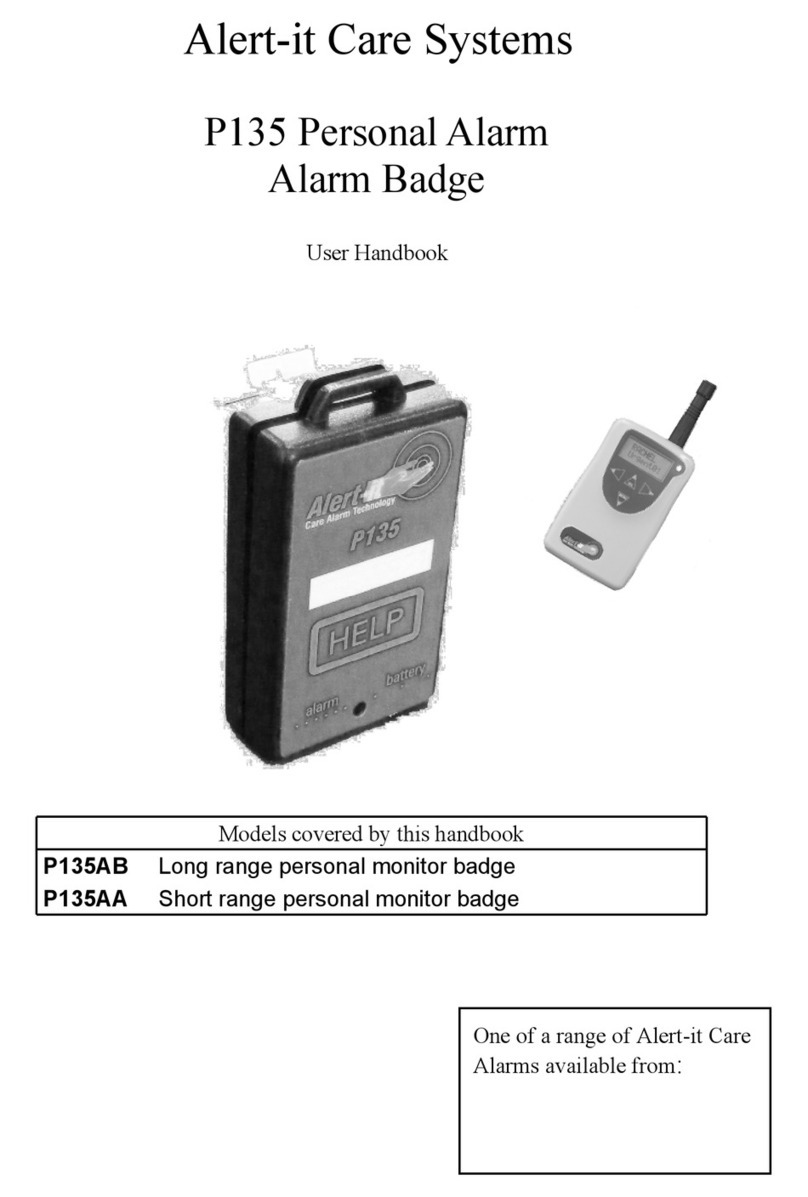
Alert-it Care Systems
Alert-it Care Systems P135 User handbook
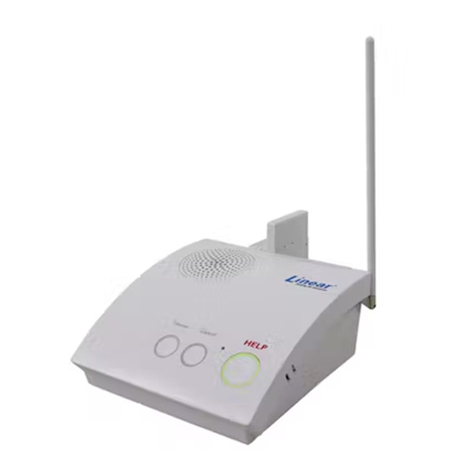
Linear
Linear PERS-4200 Series Installation & operation instructions
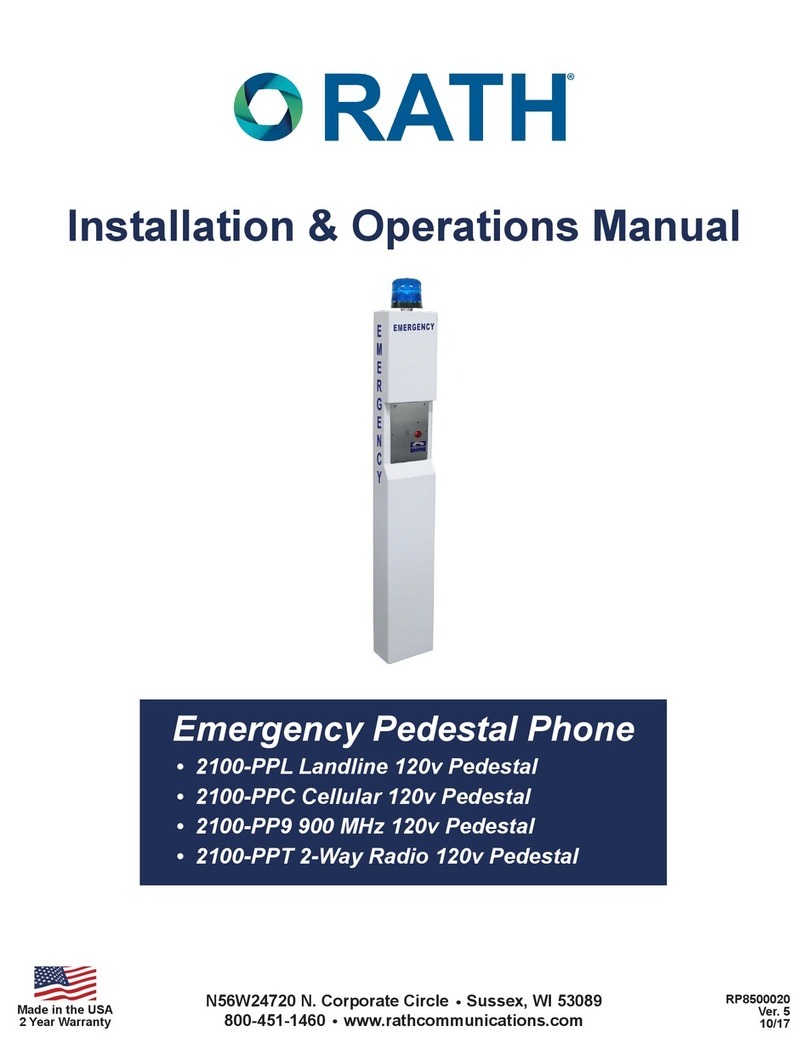
Rath
Rath 2100-PPL Installation & operation manual
